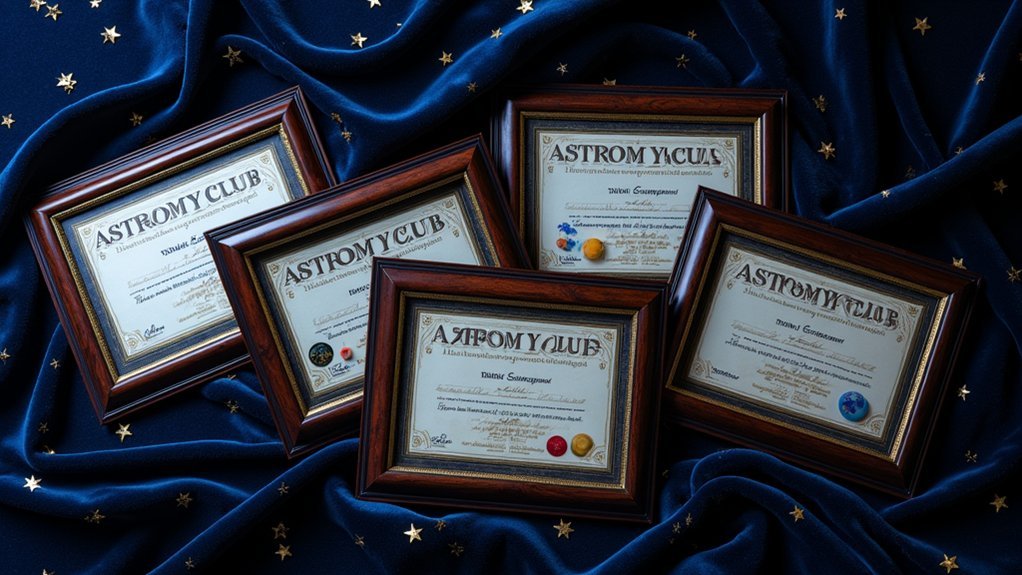You’ll easily identify three essential sky objects with basic equipment or your naked eye: the Moon with its craters and maria, bright wandering planets like Venus and Jupiter, and recognizable star patterns including the Big Dipper and Orion. These celestial objects have captivated humanity for millennia through their beauty and consistent patterns. Discover these accessible wonders, and you’ll open the first doorway to deeper astronomical exploration.
The Moon: Earth’s Captivating Natural Satellite

When you gaze up at the night sky, you’ll find Earth’s only natural satellite dominating the view. The Moon, about one-quarter our planet’s size, exerts a gravitational influence that creates ocean tides and stabilizes Earth’s axial tilt, affecting our climate patterns.
You’ll notice distinct surface features including dark maria, highlands, and numerous craters. The largest crater, Tycho, spans an impressive 85 kilometers across.
The Moon completes its orbit around Earth in approximately 27.3 days, which matches its rotation period—that’s why you always see the same side.
Humans have walked on the lunar surface during NASA’s Apollo program, with Apollo 11 making history on July 20, 1969.
This celestial neighbor continues to captivate astronomers and casual stargazers alike.
Bright Wandering Planets of Our Solar System
Unlike stars that remain fixed in position relative to each other, planets move across the celestial sphere, which is why ancient astronomers called them “wanderers.” You can spot five planets with your naked eye: Mercury, Venus, Mars, Jupiter, and Saturn.
Mercury, closest to the Sun, appears briefly at dawn or dusk, making it tricky to observe.
Venus shines brilliantly as the “Morning Star” or “Evening Star” and is our solar system’s hottest planet at 465°C.
Mars stands out with its distinctive reddish color, drawing interest for potential colonization.
Jupiter, our largest planet, features a magnetic field and the Earth-sized Great Red Spot storm.
Saturn’s magnificent rings make it arguably the most stunning planetary sight.
Each planet follows different visibility patterns throughout the year.
Recognizable Star Patterns and Constellations

Although planets wander across our night sky, stars form fixed patterns that have guided humanity for millennia.
While planets drift through the heavens, the eternal constellations have served as humanity’s celestial compass since time immemorial.
You’ll easily spot the Big Dipper in the Northern Hemisphere, which points directly to Polaris, our North Star. In winter, look for Orion with its distinctive three-star belt and brilliant Betelgeuse and Rigel stars.
Summer evenings feature the Summer Triangle, formed by bright stars Deneb, Vega, and Altair—perfect for charting the night sky.
If you’re in the Southern Hemisphere, the Southern Cross (Crux) serves as an essential navigation tool and holds cultural significance worldwide.
Don’t miss Cassiopeia‘s distinctive W-shape, which helps locate both the North Star and nearby star clusters.
These recognizable asterisms connect us to ancient storytellers who first mapped these celestial objects into the patterns we cherish today.
Frequently Asked Questions
What Are the Common Astronomical Objects?
You’ll find stars, planets, galaxies, nebulae, and black holes among common astronomical objects. Each has unique characteristics—from our Sun’s nuclear fusion to the light-swallowing gravitational pull of black holes.
What Are the 3 Objects Found in Space?
You’ll find stars, planets, and galaxies as the three primary objects in space. Stars generate energy through fusion, planets orbit around stars, and galaxies contain billions of stars including our own Milky Way.
What Are the DSO Objects?
DSO (Deep-Sky Objects) are celestial bodies beyond our solar system. You’ll find three main types: nebulae (gas clouds), star clusters (both globular and open), and galaxies (spiral, elliptical, and irregular systems).
What Is the Coolest Object in Space?
The coolest object in space is the Boomerang Nebula. At -272°C, it’s just 1°C above absolute zero, making it even colder than the cosmic background radiation. You’ll find it 5,000 light-years away in Centaurus.
In Summary
You’re now equipped to appreciate the night sky with newfound understanding. Whether you’re tracking the Moon’s changing phases, spotting Venus and Jupiter as they wander among the stars, or locating Orion’s distinctive belt, you’ve mastered the basics. Don’t stop here—your celestial journey‘s just beginning. Keep looking up, and you’ll discover countless more wonders awaiting your gaze.





Leave a Reply